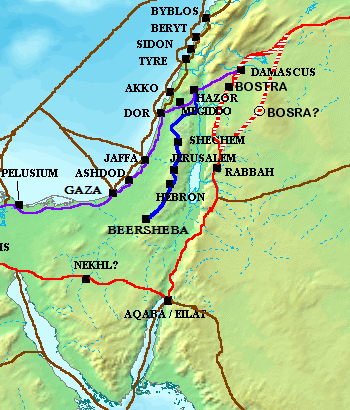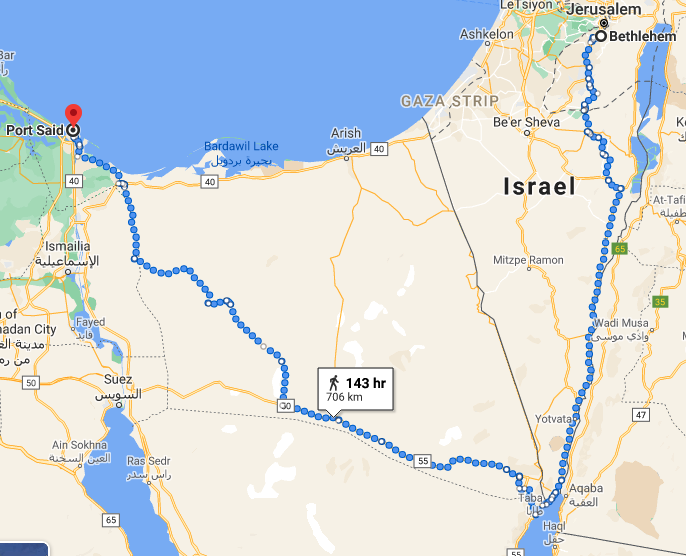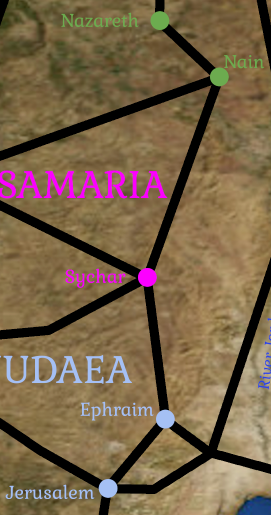With this week’s article, we finish looking at Jesus’ earliest days. Last week we looked at Matthew 2, the story of the wise men from the east, and specifically we looked at Joseph taking Mary and Jesus to Egypt.
Now when they had departed, behold, an angel of the Lord appeared to Joseph in a dream, saying, “Arise and take the young child and his mother, and flee into Egypt, and stay there until I tell you, for Herod will seek the young child to destroy him.” (Matthew 2:13)
So, Joseph took his young family to Egypt. We don’t know what route they took, but I used the journey as an opportunity to talk about the route called “The Way to Shur”, about Abraham and Isaac’s journey from Mount Moriah to Beersheba, about Hagar fleeing Sarai towards Egypt, and about the Israelites wandering in the wilderness of Shur.
Today, the text takes us back to Israel, and specifically to Nazareth.
But when Herod was dead, behold, an angel of the Lord appeared in a dream to Joseph in Egypt, saying, 20 “Arise and take the young child and his mother, and go into the land of Israel, for those who sought the young child’s life are dead.” 21 He arose and took the young child and his mother, and came into the land of Israel. 22 But when he heard that Archelaus was reigning over Judea in the place of his father, Herod, he was afraid to go there. Being warned in a dream, he withdrew into the region of Galilee, 23 and came and lived in a city called Nazareth; that it might be fulfilled which was spoken through the prophets that he will be called a Nazarene. (Matthew 2:19-23)
It’s not clear from the text whether the young family returned to Bethlehem first, or whether they went straight to Nazareth. I will assume the latter as an opportunity to talk about another of the major routes connecting Egypt and Israel (and really all of Asia and Europe).
The main highway from Egypt to the north and east is called by various names. Many scholars call it the Via Maris (or the way of the sea); many scholars of Biblical history call it the Great Trunk Road; and the Bible references it as “the way of the land of the Philistines” (Exodus 13:17).
As you might’ve guessed, at least in part, it travels along the coast of the Mediterranean Sea on the western edge of Israel. As a major route, it was a well patrolled highway making it a relatively safe and easy way to reach especially the northern parts of Israel. However, its prominence also meant that, at times, key Biblical figures avoided using this highway to avoid being noticed. The highway also doesn’t get very close to the towns in the Judean hills, like Bethlehem and Jerusalem. But for someone wanting to go from Egypt to Nazareth, the Via Maris or Great Trunk Road would be a great choice.
Israel’s Mediterranean coast is unlike what I tend to think of when I think of other countries on this inland (its name literally means middle of the earth) sea. Unlike the major seagoing nations, Israel lacked a true natural deep water port. Here at the very eastern end of the Mediterranean, the seabed gently rises to the coastline. Sure, we read of Jonah putting to sea from Joppa in a relatively small ship (Jonah 1:3), but King Solomon had to do his major shipping out of the Gulf of Aqaba (2 Chronicles 8:17-18) rather than the Mediterranean.
Herod, however, sought to change that. He wanted a grand entrance to his kingdom, and so he built Caesarea Maritima, or simply Caesarea. Herod built many places that he named Caesarea to pay homage to his emperor, Caesar Augustus. Caesarea Maritima, about 35 miles north of Joppa, was a grand Roman city, but perhaps its greatest engineering feat was the creation of a man-made harbor. Stone blocks 50 x 18 x 10 foot were manually placed in the water to create an artificial breakwater.
As Bible readers, we perhaps know Caesarea best for the story of the Roman centurion Cornelius based in that city, who, at God’s command, sent to Joppa for Peter (Acts 10:1,5). But 30+ years prior to that glorious event of the gospel going to the gentiles, I imagine that Joseph would’ve approached this massive symbol of Herod’s power with trepidation.
At Caesarea, the Great Trunk Road bends inland, but still heading north, taking a route that would pass close by Nazareth.

If we read further into Acts, we encounter Caesarea again as Paul’s both prison and sanctuary (Acts 23:23-24) and the starting point for his journey to Rome. May we, like Paul, trust our sovereign God and be faithful to fearlessly carry Christ’s name to those who are perishing (Acts 9:15-16).
—
The map at the top of this post is sourced from Wikipedia. This is the attribution: Atefrat, CC BY-SA 3.0, via Wikimedia Commons.
The map towards the bottom of this post shows part of the gameboard of the current prototype of the Journeys with Jesus game.
If you’ve found this interesting and would like to continue to read these stories of the journeys and places in Journeys with Jesus, sign up in the sidebar to receive updates.
Note: all scripture quotes, unless otherwise noted, are from the World English Bible which is in the public domain.




 I believe that the next journey that Jesus took was from Jerusalem to Nazareth, still as a tiny baby. As I’ve said in previous posts, Jerusalem was in Judea in the south of Israel, while Nazareth was in Galilee in the north.
I believe that the next journey that Jesus took was from Jerusalem to Nazareth, still as a tiny baby. As I’ve said in previous posts, Jerusalem was in Judea in the south of Israel, while Nazareth was in Galilee in the north.
 Bethlehem was not far from Jerusalem, just 8 km or 5 miles (less than a 2 hour walk according to Google Maps). Although the elevation of Bethlehem and Jerusalem are similar, they would’ve passed through a couple of dips, with the final climb into the royal city being fairly steep.
Bethlehem was not far from Jerusalem, just 8 km or 5 miles (less than a 2 hour walk according to Google Maps). Although the elevation of Bethlehem and Jerusalem are similar, they would’ve passed through a couple of dips, with the final climb into the royal city being fairly steep.
 Jesus’ second journey, still in Mary’s womb, was from Nazareth to Bethlehem. As with last week’s journey, this was a relatively long one. Nazareth is in the north, in Galilee, and Bethlehem is in the south, in Judaea. According to Google Maps, the distance is about 160 km (or almost 100 miles) and would take 33 hours on foot on today’s modern paths and roads.
Jesus’ second journey, still in Mary’s womb, was from Nazareth to Bethlehem. As with last week’s journey, this was a relatively long one. Nazareth is in the north, in Galilee, and Bethlehem is in the south, in Judaea. According to Google Maps, the distance is about 160 km (or almost 100 miles) and would take 33 hours on foot on today’s modern paths and roads.

 Jesus’ first journey is described later in Luke 1 when Mary, carrying Jesus in her womb, visits her relative Elizabeth. We don’t know exactly where Elizabeth and her husband Zacharias lived, it is only referenced as “a city of Judah”.
Jesus’ first journey is described later in Luke 1 when Mary, carrying Jesus in her womb, visits her relative Elizabeth. We don’t know exactly where Elizabeth and her husband Zacharias lived, it is only referenced as “a city of Judah”.